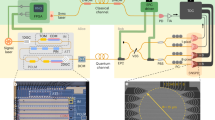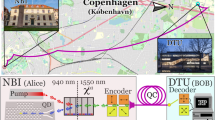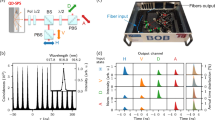Abstract
We report the first quantum key distribution (QKD) experiment to enable the creation of secure keys over 42 dB channel loss and 200 km of optical fibre. We used the differential phase shift QKD (DPS-QKD) protocol, implemented with a 10-GHz clock frequency and superconducting single-photon detectors (SSPD) based on NbN nanowires. The SSPD offers a very low dark count rate (a few Hz) and small timing jitter (60 ps, full width at half maximum, FWHM). These characteristics allowed us to achieve a 12.1 bit s–1 secure key rate over 200 km of fibre, which is the longest terrestrial QKD over a fibre link yet demonstrated. Moreover, this is the first 10-GHz clock QKD system to enable secure key generation. The keys generated in our experiment are secure against both general collective attacks on individual photons and a specific collective attack on multiphotons, known as a sequential unambiguous state discrimination (USD) attack.
This is a preview of subscription content, access via your institution
Access options
Subscribe to this journal
Receive 12 print issues and online access
$209.00 per year
only $17.42 per issue
Buy this article
- Purchase on Springer Link
- Instant access to full article PDF
Prices may be subject to local taxes which are calculated during checkout





Similar content being viewed by others
References
Gisin, N., Ribordy, G., Tittel, W. & Zbinden, H. Quantum cryptography. Rev. Mod. Phys. 74, 145–195 (2002).
Vernam, G. S. Cipher printing telegraph systems for secret wire and radio telegraphic communications. J. Am. Inst. Elec. Eng. 45, 109–115 (1926).
Bennett, C. H., Bessette, F., Brassard, G., Salvail, L. & Smolin, J. Experimental quantum cryptography. J. Cryptology 5, 3–28 (1992).
Bennett, C. H. & Brassard, G. Quantum cryptography: Public key distribution and coin tossing, in Proceedings of IEEE International Conference of Computer Systems and Signal Processing, Bangalore, India, 175–179 (IEEE, New York, 1984).
Lütkenhaus, N. Security against individual attacks for realistic quantum key distribution. Phys. Rev. A 61, 052304 (2000).
Brassard, G., Lütkenhaus, N., Mor, T. & Sanders, B. C. Limitations on practical quantum cryptography. Phys. Rev. Lett. 85, 1330–1333 (2000).
Santori, C., Fattal, D., Vuc̆ković, J., Solomon, G. S. & Yamamoto, Y. Indistinguishable photons from a single-photon device. Nature 419, 594–597 (2002).
Kuhn, A., Hennrich, M. & Rempe, G. Deterministic single-photon source for a distributed quantum networking. Phys. Rev. Lett. 89, 067201 (2002).
McKeever, J. et al. Deterministic generation of single photons from one atom trapped cavity. Science 303, 1992–1994 (2004).
Waks, E. et al. Quantum cryptography with a photon turnstile. Nature 420, 762 (2002).
Beveratos, A. et al. Single photon quantum cryptography. Phys. Rev. Lett. 89, 187901 (2002).
Waks, E., Santori, C. & Yamamoto, Y. Security aspects of quantum key distribution with sub-Poisson light. Phys. Rev. A 66, 042315 (2002).
Hwang, W. Y. Quantum key distribution with high loss: toward global secure communication. Phys. Rev. Lett. 91, 057901 (2003).
Lo, H. K., Ma, X. & Chen, K. Decoy state quantum key distribution. Phys. Rev. Lett. 94, 230504 (2005).
Wang, X. B. Beating the photon-number-splitting attack in practical quantum cryptography. Phys. Rev. Lett. 94, 230503 (2005).
Ma, X., Qi, B., Zhao, Y. & Lo, H. K. Practical decoy state for quantum key distribution. Phys. Rev. A 72, 012326 (2005).
Bennett, C. H. Quantum cryptography using any two nonorthogonal states. Phys. Rev. Lett. 68, 3121–3124 (1992).
Koashi, M. Unconditional security of coherent-state quantum key distribution with a strong phase-reference pulse. Phys. Rev. Lett. 93, 120501 (2004).
Scarani, V., Acín, A., Ribordy, G. & Gisin, N. Quantum cryptography protocols robust against photon number splitting attacks for weak laser pulse implementation. Phys. Rev. Lett. 92, 057901 (2004).
Stucki, D., Brunner, N., Gisin, N., Scarani, V. & Zbinden, H. Fast and simple one-way quantum key distribution. Appl. Phys. Lett. 87, 194108 (2005).
Inoue, K., Waks, E. & Yamamoto, Y. Differential-phase-shift quantum key distribution. Phys. Rev. Lett. 89, 037902 (2002).
Rosenberg, D. et al. Long distance decoy state quantum key distribution in optical fiber. Phys. Rev. Lett. 98, 010503 (2007).
Waks, E., Takesue, H. & Yamamoto, Y. Security of differential-phase-shift quantum key distribution against individual attacks. Phys. Rev. A 73, 012344 (2006).
Takesue, H. et al. Differential phase shift quantum key distribution over 105 km fibre. New J. Phys. 7, 232 (2005).
Diamanti, E., Takesue, H., Langrock, C., Fejer, M. M. & Yamamoto, Y. 100 km secure differential phase shift quantum key distribution with low jitter up-conversion detectors. Opt. Express 14, 13073–13082 (2006).
Gol'tsman, G. N. et al. Picosecond superconducting single-photon optical detector. Appl. Phys. Lett. 79, 705–707 (2001).
Verevkin, A. et al. Detection efficiency of large-active area NbN single-photon superconducting detectors in the ultraviolet to near-infrared range. Appl. Phys. Lett. 80, 4687–4689 (2002).
Curty, M., Zhang, L.-L., Lo, H.-K. & Lütkenhaus, N. Sequential attacks against differential-phase-shift quantum key distribution with weak coherent states. Preprint at <http://arxiv.org/abs/quant-ph/0609094> (2006).
Bennett, C. H., Brassard, G., Crépeau & Maurer, U. M. Generalized privacy amplification. IEEE Trans. Inf. Theory 41, 1915–1923 (1995).
Fasel, S. et al. High-quality asynchronous heralded single-photon source at telecom wavelength. New J. Phys. 6, 163 (2004).
Trifonov, A. & Zavriyev, A. Secure communication with a heralded single-photon source. J. Opt. B 7, S772–S777 (2005).
Soujaeff, A. et al. Quantum key distribution at 1550 nm using a pulse heralded single photon source. Opt. Express 15, 726–734 (2007).
Hadfield, R. H. et al. Single photon source characterization with a superconducting single photon detector. Opt. Express 13, 10846–10853 (2005).
Il'in, K. S. et al. Picosecond hot-electron energy relaxation in NbN superconducting photodetectors. Appl. Phys. Lett. 76, 2752–2754 (2000).
Kurtsiefer, C. et al. A step towards global key distribution. Nature 419, 450 (2002).
Ursin, R. et al. Free-space distribution of entanglement and single photons over 144 km. Preprint at <http://arxiv.org/abs/quant-ph/0607182> (2006).
Schmitt-Manderback, T. et al. Experimental demonstration of free-space decoy-state quantum key distribution over 144 km. Phys. Rev. Lett. 98, 010504 (2007).
Collins, R. J., Hadfield, R. H., Fernandez, V., Nam, S. W. & Buller, G. S. Low timing jitter detector for gigahertz quantum key distribution. Electron. Lett. 43, 180–182 (2007).
Hiskett, P. A. et al. Long-distance quantum key distribution in optical fibre. New J. Phys. 8, 193 (2006).
Acknowledgements
The authors thank E. Diamanti, M. M. Fejer, G. N. Gol'tsman, E. Ip, J. M. Kahn, G. Kalogerakis, L. G. Kazovsky, N. Y. Kim, C. Langrock, R. V. Roussev and Y. Tokura for their support during this research. Financial support was provided by the CREST and SORST programs of the Japan Science and Technology Agency (JST), the National Institute of Information and Communications Technology (NICT) of Japan, the MURI Center for Photonic Quantum Information Systems (ARO/ARDA DAAD19-03-1-0199), DTO, DARPA and the NIST Quantum Information Science Initiative.
Author information
Authors and Affiliations
Contributions
H. Takesue designed and performed the experiments, analysed the data and wrote the paper, S. W. Nam performed the experiments and analysed the data, Q. Zhang performed the experiments, R. H. Hadfield performed the experiments, T. Honjo analysed the data, K. Tamaki analysed the data, and Y. Yamamoto planned the experiments.
Corresponding author
Ethics declarations
Competing interests
The authors declare no competing financial interests.
Rights and permissions
About this article
Cite this article
Takesue, H., Nam, S., Zhang, Q. et al. Quantum key distribution over a 40-dB channel loss using superconducting single-photon detectors. Nature Photon 1, 343–348 (2007). https://doi.org/10.1038/nphoton.2007.75
Received:
Accepted:
Published:
Issue Date:
DOI: https://doi.org/10.1038/nphoton.2007.75
This article is cited by
-
High-rate quantum key distribution exceeding 110 Mb s–1
Nature Photonics (2023)
-
Phase encoded quantum key distribution up to 380 km in standard telecom grade fiber enabled by baseline error optimization
Scientific Reports (2023)
-
Applications of single photons to quantum communication and computing
Nature Reviews Physics (2023)
-
Topological phase singularities in atomically thin high-refractive-index materials
Nature Communications (2022)
-
Photon counting of extreme ultraviolet high harmonics using a superconducting nanowire single-photon detector
Applied Physics B (2022)



